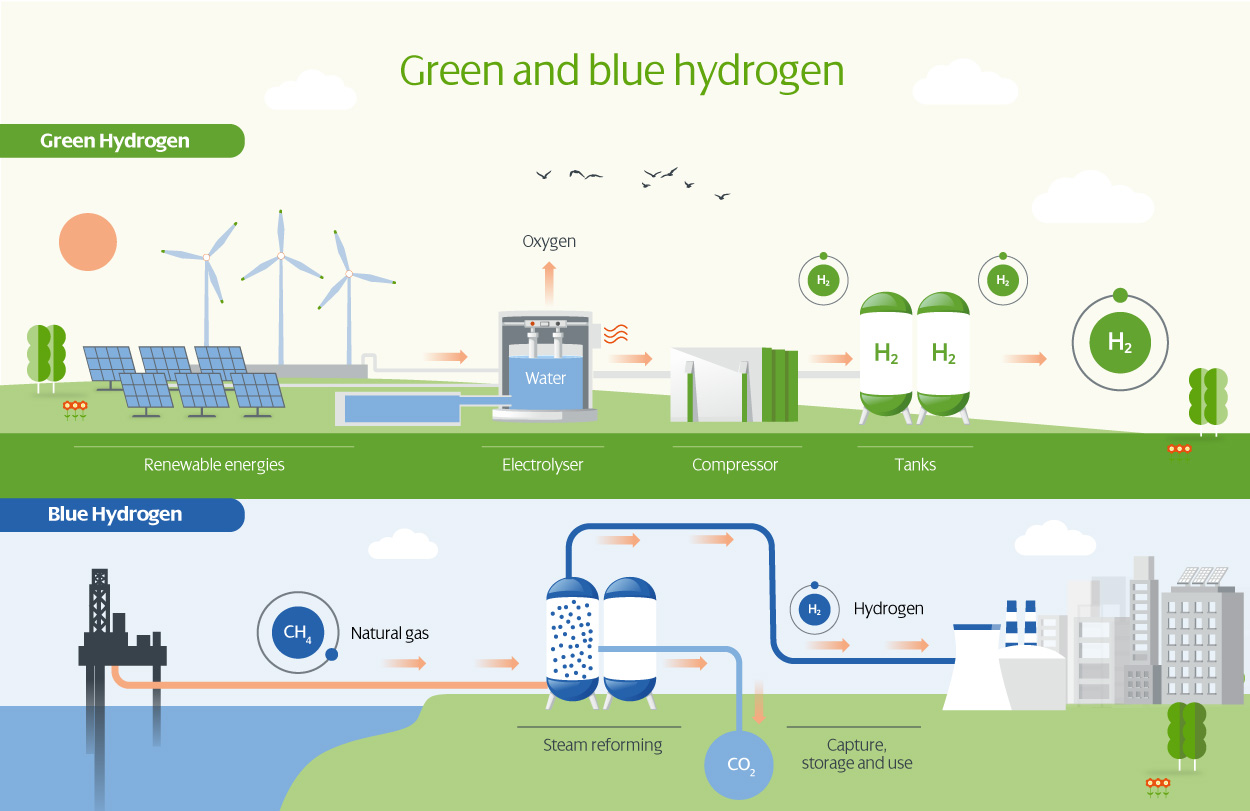Challenges and opportunities of green hydrogen
Green Hydrogen’s promise for a carbon-free future
Green hydrogen Decarbonisation
June 2023. Reading time: 8 minutes
Solar and wind energy have grown significantly on the electric grid over the last decade, but when the sun doesn’t shine and the wind doesn’t blow, green hydrogen can bridge the gap.
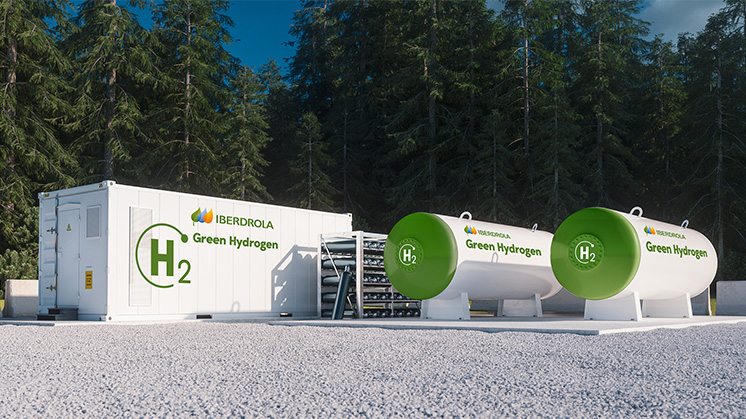
Hydrogen produced with renewable energy can help decarbonize industrial processes such as fertilizer manufacturing and power big vehicles.
In the Zona Franca area of Barcelona, municipal buses pull into a service station at the end of a shift to fuel up, just as they do in cities all over the world. But the station here is different. Instead of pumping gas or diesel, it dispenses compressed hydrogen gas. And it represents a key element of the green energy revolution.
Solar and wind energy met 10.5 % of the world’s power generation needs in 2021. That may not sound like a lot, but it was more than ten times the amount of only a decade ago, and U.S. renewable power generation alone is poised to grow by 82 % by 2030.
That’s good as the global economy works to lower greenhouse gas emissions, including carbon dioxide (CO2) from fossil fuels. But wind and solar energy can’t fully meet demand without a way to compensate for daily and seasonal drops in production. That’s where green hydrogen comes in.
“The important thing about grid stability, as we progressively go towards renewable systems, is intermittency,” says Adolfo Rivera, senior director of green hydrogen at AVANGRID, whose parent company, Iberdrola, built Barcelona’s hydrogen fueling station. “If you can create hydrogen with [wind and solar] energy and store it, you can use it when the grid requires it. Hydrogen is a great energy vector”.
Hydrogen produced with renewable energy can also help decarbonize industrial processes such as fertilizer manufacturing and power big vehicles —including Barcelona’s buses.
The many colors of hydrogen
Globally, electric generation and transportation represent the two biggest sources of carbon dioxide emissions. But solar and wind energy alone can only get the world part way to the zero emissions called for by the UN Intergovernmental Panel on Climate Change to avoid the most catastrophic effects of climate change.
That’s because wind and solar energy don’t deliver full-time and chemical batteries can take trucks, ships and airplanes only so far. What’s needed is a way to convert wind and solar energy into a concentrated, storable form that doesn’t degrade over time. In other words, into fuel.
Hydrogen is the most abundant element in the universe. In fact, we drink it every day in H2O. It is also an efficient, non-polluting fuel whose only combustion product is water. NASA even chose hydrogen to power its new moon rocket because it’s the most efficient rocket fuel, providing the biggest kick per unit of mass than any other propellant.
However, despite its abundance and suitability as a fuel, hydrogen production typically relies on fossil fuels to produce what’s known as gray hydrogen. “You also have pink hydrogen, which is the one you can produce with nuclear energy,” explains Enrique Bosch, director of innovation at AVANGRID. “Here there are no CO2 emissions, but you are generating nuclear waste, so it’s not, in our opinion, as good.” He is similarly down on blue hydrogen, produced in a process that captures most, but not all, of the emissions of gray hydrogen. “It’s another solution, in our opinion, that is not as good as the green one because you are emitting some CO2,” Bosch says.
Green hydrogen, on the other hand, gets produced with electricity from renewable, non-carbon-emitting sources such as wind and solar energy. Carbon-free energy splits water into its constituent element —hydrogen and oxygen— in a process known as electrolysis. Run the process in reverse —combining hydrogen with oxygen in a device known as a fuel cell— and you get electricity.
It’s electricity produced this way that powers Barcelona’s new buses, although it can also be burned directly as an emissions-free fuel for internal combustion engines; its only by-product is water.
On each of Barcelona’s new fuel-cell-powered buses, onboard hydrogen tanks supply a fuel cell that charges a conventional lithium-ion battery. The battery then powers an electric motor, just as in pure electric vehicles (EVs). The main advantage over EVs without fuel cells is that the hydrogen tanks can store more energy than batteries, giving the vehicles more range. They can also fuel up faster than conventional EVs can charge (a few minutes vs. an hour or more). Those advantages make hydrogen power attractive for heavier, long-haul vehicles, like municipal buses, which may have to run many hours between fueling stops.
Despite the advantages, challenges remain for the broad adoption of hydrogen for energy storage.
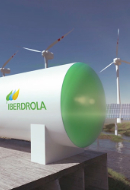
Green hydrogen
An alternative that reduces emissions and cares for our planet.
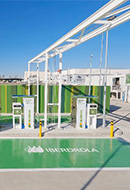
Hydrogen stations
What are hydrogen stations and how do they work?
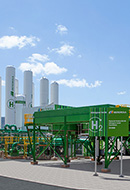
Difference between green and blue hydrogen
Discover the importance of the colours of hydrogen.

Green ammonia
The sustainable revolution in the chemical industry.
Towards a hydrogen economy
Widespread networks do not yet exist for transporting and storing hydrogen on the scale needed to replace fossil fuels for transportation and power grid generation. Besides being the most abundant element, hydrogen is also the lightest, making it difficult to hold on to. “It’s different from natural gas,” Bosch says. That means unmodified pipelines and tanks for other fuels won’t work. Even so, Bosch sees no show-stoppers. “We know how to store hydrogen,” he says. “We understand the element. We know the kind of equipment we have to use.”
The biggest challenge Bosch sees is scaling up the infrastructure needed to supply millions of vehicles, power plants and factories. “We need to scale that to the same level we have for natural gas.” Yet, without the demand that already exists for, say, electricity, costs remain high, which in turn inhibits the adoption of hydrogen as a fuel. It’s one reason pure EVs have taken off faster than hydrogen-powered ones. Despite the ongoing need for more public charging infrastructure, drivers can still plug in at home with few or no upgrades — they can even recharge using ordinary wall outlets, albeit slowly.
The future of the grid
According to Bosch, government incentives will be needed to achieve the global economies of scale that will let green hydrogen fill the gaps left by intermittent forms of renewable energy. “Today, it’s difficult to compete with the traditional sources of hydrogen,” he says. “But we have some funding programs now in the U.S., so I think the green hydrogen economy can develop to the same level and compete in the same price range as other colors.” For example, in 2022, the U.S. Department of Energy launched the $8 billion program to build regional clean hydrogen hubs called for in the Bipartisan Infrastructure Law, which passed in late 2021.
Once green hydrogen achieves price parity with other fuels, Bosch believes the green hydrogen economy will take off. Indeed, it must for the global economy to go carbon-free, according to McKinsey & Company. Bosch expects to see green hydrogen powering the shipping industry and supplying processes such as fertilizer manufacturing within ten years. “This is the right place to be at the right time in this energy transition movement,” he says. “It is an amazing moment.”
Meanwhile, Barcelona’s hydrogen-powered bus initiative is charging ahead. The Barcelona transit authority took delivery of its first hydrogen-powered bus in late 2021, added seven more to its fleet in 2022, and plans to ramp up to 60 by 2025.
Source: Washington Post





